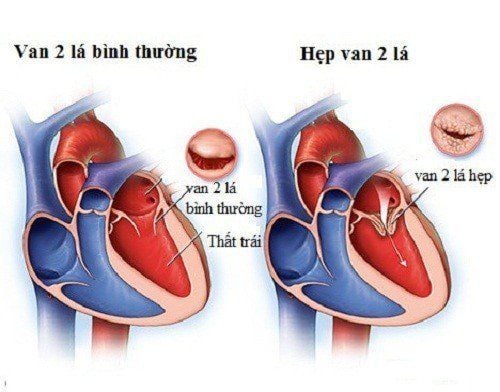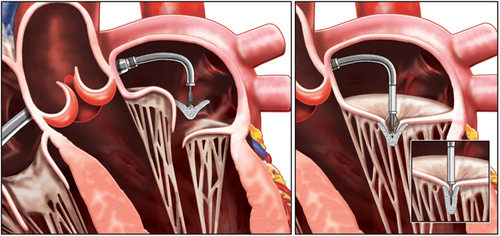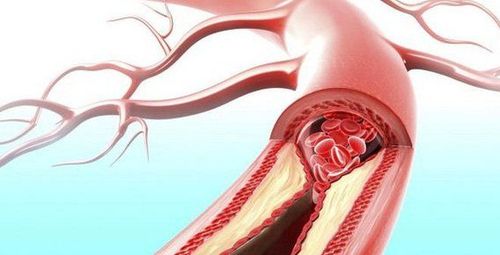This is an automatically translated article.
Mitral valve disease is a common heart valve disease, especially in Vietnam, the number of patients with mitral valve disease is high as a result of rheumatic heart disease. Mitral valve replacement surgery is a radical, effective and last resort treatment for severe mitral valve disease. So what are the treatment methods for mitral valve disease?1. What is mitral valve disease?
Mitral valve is the valve between the left atrium and left ventricle, the mitral valve has the function of controlling one-way blood flow from the left atrium to the left ventricle from there to feed the body
Mitral valve disease includes: Mitral stenosis, Mitral regurgitation, which can be simple mitral stenosis, simple mitral regurgitation, or a combination of stenosis and mitral regurgitation.
The main causes of mitral valve disease include: rheumatic heart valve damage, infective endocarditis, a consequence of myocardial infarction, due to degeneration, congenital heart disease or trauma.
The progression and prognosis of mitral valve disease depends on the mitral valve injury (valvular stenosis, valvular regurgitation or a combination of stenosis and regurgitation), the extent of the lesion, the duration of the disease. disease and associated lesions, if any, the disease often progresses silently until symptoms are evident, the final result is dilation of the heart chambers, heart failure, and increased pulmonary artery pressure.

Hẹp van hai lá
2. Treatment methods for mitral valve disease
Principle: The treatment of mitral valve should be based on: Damage to the mitral valve, stage of the disease, presence or absence of clinical symptoms, combined damage and the patient's condition
2.1 Internal treatment Department and follow-up Apply to early stage mitral valve lesions, no or mild clinical symptoms, heart valve damage is not too severe, cardiac function is compensated. Or applied to cases where the disease is too severe to be or is no longer indicated for surgery or intervention
Depending on the specific pathology, the cardiologist will examine, evaluate and prescribe as well as plan follow-up for each patient. The purpose of medical treatment is to relieve symptoms, limit disease progression, prevent complications (such as acute heart failure, acute pulmonary edema, embolism, arrhythmia..)
Commonly used drugs for the treatment of mitral valve disease such as: ACE inhibitors, beta-blockers, diuretics, digoxin, or anticoagulants..)
During medical follow-up, patients may be prescribed Mitral valve replacement/repair surgery or intervention if indicated.
2.2 Percutaneous intervention for the treatment of some mitral valve diseases 2.2.1 Percutaneous mitral stenosis treatment of mitral stenosis Percutaneous balloon dilatation is a cardiovascular interventional technique to treat valve stenosis 2 A balloon of a certain size is delivered to the mitral valve position through the femoral vein and right atrium and then into the left atrium and mitral valve. The balloon will be pumped up and down one or more times to separate the two rims of the narrowed mitral valve.
Patients with mitral stenosis assigned to this method should satisfy the following conditions: mitral stenosis, clinical symptoms from NYHA II or higher, valve morphology on ultrasound consistent with dilation , no thrombus in the heart chamber, no mitral regurgitation or moderate aortic regurgitation
This is a fairly safe, effective, low-complicated method, the procedure time is fast, Applied in Vietnam since 1997, bringing joy to many patients
2.2.2 Repairing the mitral valve through the catheter (Mitra clip technique) to treat mitral regurgitation. The catheter, also known as the Mitra clip technique, is the latest method today to treat mitral valve regurgitation for patients, this is a method of using a device called a mitra clip that is inserted into the position of the mitral valve. Through the patient's blood vessels, this device will clamp the 2 leaflets of the mitral valve that are open to create the mitral orifice as shown in figure 8, greatly reducing the degree of mitral regurgitation, reducing the backflow of blood through the patient's blood vessels. 2-leaf valve systolic, thereby reducing symptoms and improving heart failure for the patient. This technique is applied to cases of moderate to severe mitral regurgitation, grade 3+ or higher on echocardiography, with clinical symptoms and satisfying technical conditions (such as no rupture of the heart and the lungs). valvular ligaments, appropriate position of the leaflets..)
This is a new method with many advantages such as: the patient does not have to have open surgery, no anesthesia, no extracorporeal circulation, time. Short hospital stay is usually only about 3 days, high efficiency, especially good for patients with high risk of surgery, severe comorbidities, but the cost is still high.

Mitra clip điều trị hở van 2 lá là phương pháp mới đang được áp dụng hiện nay tại Vinmec
2.3 Mitral valve replacement or repair surgery 2.3.1 Mitral valve repair surgery: With some cases of mitral regurgitation: Depending on the mechanism causing the valve regurgitation, the surgeons will take measures to correct the edema. such as cutting, suturing too long ligaments or placing a mitral annulus to reduce the mitral annulus diameter.
The mitral valve repair technique helps to preserve the natural valve structure, which can help patients not need to take anticoagulants for life, but requires experienced surgeons and is not a case of valve damage. Any 2 cards can be repaired.
2.3.2 Mitral valve replacement surgery : Heart valve replacement surgery is necessary when the heart valve is severely damaged, unable to be repaired or medical treatment does not respond. New valve replacement is intended to relieve symptoms and prevent future heart failure, arrhythmias, and other complications.
Vinmec Times City International General Hospital applies mitral valve replacement surgery with a 95% survival rate. The technique is performed by leading specialists such as Dr. Nguyen Xuan Thanh. The advantages of mitral valve replacement surgery at Vinmec include:
Hybrid operating room is equipped with advanced equipment such as DSA angiography machine, anesthesia machine integrated with patient hemodynamic monitoring software closely. (PiCCO system, entropy,...). Therefore, the Hybrid operating room can meet the requirements of surgery and angioplasty, coronary stenting, aortic stent graft, open heart surgery, heart valve replacement for congenital heart diseases with modern minimally invasive techniques. most invasive, safe, help patients recover health soon.
BS. Cardiologists have been trained and certified to perform techniques
So far, the hospital has successfully treated 50 cases. Hospital discharge survival rate 95% (international 88-90%).
Please dial HOTLINE for more information or register for an appointment HERE. Download MyVinmec app to make appointments faster and to manage your bookings easily.













